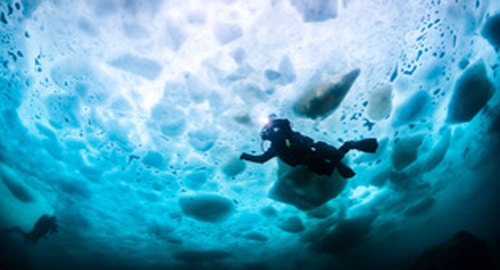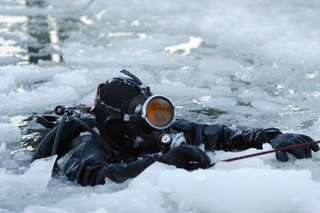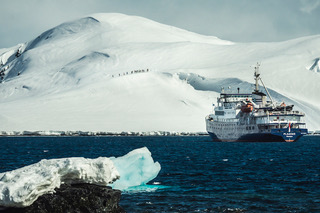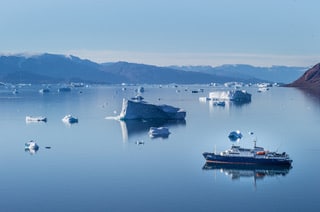News
Diving under the ice

Ice diving is one of the most adventurous types of diving and is a great way to immerse yourself in environments few other people ever get to see. It is challenging, different from most other types of recreational diving, and one to add to your liveaboard diving wish list for 2019.
Why go ice diving?
Ice diving offers the chance to experience dive sites like no other and enjoy marine life encounters you can’t find elsewhere. Surrounded by blue water and ice formations, there is nowhere as peaceful as under the ice.
Where can you go ice diving?
The Arctic and Antarctica are two of the best places to go ice diving. These unique destinations offer exceptional wildlife watching opportunities, varied diving and the chance to visit some of Earth’s last wilderness areas.
Antarctica
You can go ice diving around the Antarctic Peninsula and Weddell Sea during Antarctica liveaboard diving cruises, plus explore iconic destinations such as the Falkland Islands and South Shetland Islands. A liveaboard safari to South Georgia and the Sandwich Islands is not to be missed to explore areas that have never been dived before. These wild and remote areas are teeming with wildlife and dive trips include zodiac diving, shore dives, wall dives and ice dives.
The M/V Plancius and Ortelius both offer Antarctica dive safaris and diving is available during November to March.
The Arctic
Ice diving in the Arctic is more accessible than Antarctica for most people and the best dive sites are reached by Arctic liveaboard diving. There are varied dives on offer, including at Norway’s remote Svalbard archipelago, and you can enjoy ice diving, boat dives and even wreck dives. It is also possible to dive Scoresby Sund in Greenland; the world’s largest fjord system. Reaching depths of up to 1450 meters, this fjord is a unique liveaboard diving destination with ice and boat-based diving on offer.
The M/V Plancius offers Arctic liveaboard diving, with Scoresby Sund diving available during certain itineraries.
What can you see when ice diving?
A better question would be what can’t you see when exploring the Arctic and Antarctica. These species-rich destinations offer something for everyone to enjoy.
Antarctica hosts numerous seals, penguins, diverse bird life and around 15 whale species. Dive there and you have the chance to see sea lions, leopard seals and fur seals, plus various fish species and invertebrates. There are sea caves to explore, ice formations, kelp walls and bright blue water to immerse yourself in.
Head north to Spitsbergen and you can see equally diverse marine life, including invertebrates and plentiful fish, sea lions, bearded seals, walruses and various whale species. If you visit Scoresby Sund you might even get to see narwhals and beluga whales.
Can anyone try ice diving?
If you want to try ice diving you’ll need to be a PADI Advanced Open Water diver (or equivalent) and have a minimum of 30 logged dives. You also need to be experienced in cold water and dry suit diving.
How do ice divers stay warm?!
The water temperature in Antarctica is typically 0°C (32 °F), whilst the Arctic water temperature ranges from 5°C (41 °F) to 0°C (32 °F), dropping to -1°C (30.2°F) at Scoresby Sund. However, you shouldn’t be cold when ice diving. By using the right equipment and exposure protection, you can stay warm when diving and afterwards.
What dive gear do you need to go ice diving?
You need to bring your own dive gear, suitable for polar diving, if you want to join an Antarctic or Arctic liveaboard diving cruise. Your gear should include a dry suit, appropriate thermal undersuit, hood, gloves, boots, fins, buoyancy control device, mask, snorkel, dive computer, octopus set-up and weight belt. Other equipment that is recommended includes a compass, dive knife and underwater torch.
 Discover liveaboard diving holiday solutions around the world at Liveaboard.com.
Discover liveaboard diving holiday solutions around the world at Liveaboard.com.
Blogs
The Ocean Cleanup Breaks 10,000,000 KG Barrier

The Ocean Cleanup, the global non-profit project, has removed a verified all-time total of ten million kilograms (22 million lbs.) of trash from oceans and rivers around the world – approximately the same weight as the Eiffel Tower.
To complete its mission of ridding the oceans of plastic, The Ocean Cleanup uses a dual strategy: cleaning up the Great Pacific Garbage Patch (GPGP) to remove the plastic already afloat in the oceans, while stopping the flow of plastic from the world’s most polluting rivers.
Through cleaning operations in the GPGP and in rivers in eight countries, the cumulative total of trash removed has now surpassed ten million kilograms. This milestone demonstrates the acceleration of The Ocean Cleanup’s impact, while underlining the astonishing scale of the plastic pollution problem and the need for continued support and action.
While encouraging for the mission, this milestone is only a staging point: millions more tons of plastic still pollute our oceans and The Ocean Cleanup intends to continue learning, improving and innovating to solve this global catastrophe.
This announcement comes as governments from around the world meet to continue negotiations to develop a new legally binding instrument to end plastic pollution at INC4 in Ottawa, Canada. Representatives of The Ocean Cleanup will be in attendance and the organization will be urging decision-makers to collaborate towards a comprehensive and ambitious global treaty which addresses plastic at all stages of its life cycle and in all marine environments worldwide, including in areas beyond national jurisdiction.
It is encouraging to see that the need for remediation is reflected in the various options for potential treaty provisions. It is essential that the final treaty contains clear targets for the remediation of legacy plastic pollution, and reduction of riverine plastic emissions.
Tackling plastic pollution requires innovative and impactful solutions. The treaty should therefore incentivize the innovation ecosystem by fostering innovations that make maximal use of data, technology and scientific knowledge – such as those designed and deployed by The Ocean Cleanup.
‘After many tough years of trial and error, it’s amazing to see our work is starting to pay off – and I am proud of the team who has brought us to this point.’ said Boyan Slat, Founder and CEO of The Ocean Cleanup. ‘While we still have a long way to go, our recent successes fill us with renewed confidence that the oceans can be cleaned.’
The Ocean Cleanup was founded in 2013 and captured its first plastic in 2019, with the first confirmed catch in the GPGP coming soon after the deployment of Interceptor 001 in Jakarta, Indonesia. After surpassing one million kilograms of trash removed in early 2022, the non-profit project has since progressed to the third iteration of its GPGP cleaning solution, known as System 03, and a network of Interceptors currently covering rivers in eight countries, with more deployments set for 2024.
About The Ocean Cleanup
The Ocean Cleanup is an international non-profit organization that develops and scales technologies to rid the world’s oceans of plastic. They aim to achieve this goal through a dual strategy: stemming the inflow via rivers and cleaning up the legacy plastic that has already accumulated in the ocean. For the latter, The Ocean Cleanup develops large-scale systems to efficiently concentrate the plastic for periodic removal. This plastic is tracked and traced through DNV’s chain of custody model to certify claims of origin when recycling it into new products. To curb the tide via rivers, The Ocean Cleanup has developed Interceptor™ solutions to halt and extract riverine plastic before it reaches the ocean. Founded in 2013 by Boyan Slat, The Ocean Cleanup now employs a broadly multi-disciplined team of approximately 140. The foundation is headquartered in Rotterdam, the Netherlands.
For more information, visit: theoceancleanup.com and follow @theoceancleanup on social media.
Marine Life & Conservation
Steve Backshall to headline Shark Trust’s flagship event: For the Love of Sharks

Join a host of amazing, shark loving, speakers including Steve Backshall and the Shark Trust team for an evening celebrating shark conservation at the Royal Geographical Society in London this November.
Date: 29th November 2024
Time: 6-10pm
Location: Royal Geographical Society, London
Tickets: https://www.sharktrust.org/Event/flos24
The event will be a celebration of all things shark. Those lucky enough to get hold of tickets will hear from engaging guest speakers with a passion for sharks.
The line-up includes (*subject to change if unforeseen circumstances arise)
Steve Backshall: One of television’s busiest presenters, BAFTA award-winning wildlife expert Steve has been passionate about the wild world ever since he was young.
Steve’s impressive TV career has taken him all around the world, investigating a wide array of species and environments. Steve has filmed over 100 hours of children’s wildlife programmes with the BAFTA award winning Deadly 60 franchise and recently, with Sky Nature, for his new series ‘Whale with Steve Backshall’. He has been a patron for the Shark Trust for 10 years.
Simon Rogerson: is a photojournalist specialising in natural history, diving and the sea.
He is editor of SCUBA magazine, the official journal of the British Sub-Aqua Club. Simon started his career as a crime reporter but gravitated towards his ‘less depressing’ interest in underwater exploration, joining the staff of DIVE magazine in 1999. In 2005 he was named ‘Editor of the Year’ in the PPA’s Independent Publishing Awards. Simon also works as a freelance writer, contributing frequently to the Sunday Times and Telegraph, in addition to BBC Wildlife, Esquire, and a host of international diving magazines. He is the author of a book, Dive Red Sea, published by Ultimate Sports. Now based in Berkshire, Simon has been a Patron of the Shark Trust for 20 years.
More speakers to be announced soon. Head to the Shark Trust website to learn more.
The evening will also allow guests the final chance to see the Oceanic 31, shark art exhibition. Some of the artwork will be auctioned/raffled at the event, while the rest will be auctioned online to raise money for the Shark Trust Oceanic Programme.
For the Love of Sharks is an evening with something for everyone who is interested and fascinated by sharks. Join the Shark Trust, their Patrons, Trustees and Staff, along with a host of supporters for this celebration of shark conservation.
For more information or to buy a ticket: https://www.sharktrust.org/Event/flos24
-

 News3 months ago
News3 months agoHone your underwater photography skills with Alphamarine Photography at Red Sea Diving Safari in March
-

 News3 months ago
News3 months agoCapturing Critters in Lembeh Underwater Photography Workshop 2024: Event Roundup
-

 Marine Life & Conservation Blogs3 months ago
Marine Life & Conservation Blogs3 months agoCreature Feature: Swell Sharks
-

 Blogs2 months ago
Blogs2 months agoMurex Resorts: Passport to Paradise!
-

 Blogs2 months ago
Blogs2 months agoDiver Discovering Whale Skeletons Beneath Ice Judged World’s Best Underwater Photograph
-

 Gear Reviews3 weeks ago
Gear Reviews3 weeks agoGEAR REVIEW – Revolutionising Diving Comfort: The Sharkskin T2 Chillproof Suit
-

 Gear Reviews3 months ago
Gear Reviews3 months agoGear Review: Oceanic+ Dive Housing for iPhone
-

 Marine Life & Conservation2 months ago
Marine Life & Conservation2 months agoSave the Manatee Club launches brand new webcams at Silver Springs State Park, Florida




















